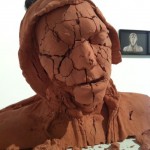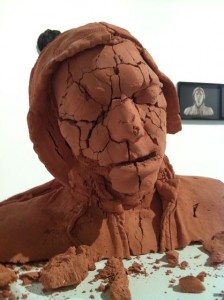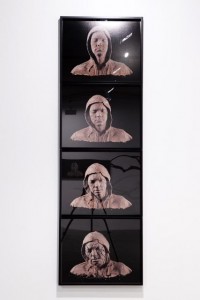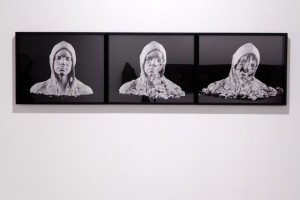Archive for October, 2011

Tim Silver stares into his own grave – and so can we
Oct 4th
 Tim Silver is a young Sydney artist whose current show (Everything in its right place, at Breenspace until October 8, 2011) is utterly hypnotic, dealing as it does with human decay and decomposition. For this exhibition, Silver created busts of his own head and shoulders – not out of bronze or marble, but out of home handyman materials such as putty or wood filler. He allowed the busts to degrade naturally over time, photographing them them to document the stages of their decline.
Tim Silver is a young Sydney artist whose current show (Everything in its right place, at Breenspace until October 8, 2011) is utterly hypnotic, dealing as it does with human decay and decomposition. For this exhibition, Silver created busts of his own head and shoulders – not out of bronze or marble, but out of home handyman materials such as putty or wood filler. He allowed the busts to degrade naturally over time, photographing them them to document the stages of their decline.
The resulting work is like fast-tracking the process by which youth becomes age and finally death. It’s as though Silver has stared into his own grave and marked the various stages of his return to the earth.
Depending on the material Silver has used to create them, the busts sag, crumble, wrinkle, and even sweat. It takes them perhaps three or four weeks to stabilise and solidify, because they have no armature to support them and they are not hollow. They are made of solid putty or wood filler.
The work at left is one of the busts. It is titled Untitled (bust) (Mahogany Timbermate Woodfiller), and was completed this year. The accompanying series of photographs (see below) shows the bust cracking, its various pieces drifting apart, the jaw hanging loose. The bust could well continue to crumble after it has been purchased, a fact which causes Silver to merely shrug.
You can’t help getting up close to these photographs, peering at them in the way you peer at photographs of Egyptian mummies or the freakishly well-preserved bodies of prehistoric ancestors such as Oetzi the Iceman. It is fascinating to look at these ancient people and imagine the vast period of time between them and us, to contemplate the shared impulses and feelings we would have, and ponder the nature of their lives and deaths. Speaking of Oetzi, it is intriguing to notice that many of Silver’s busts begin their devolution covered in a light layer of ice. This is due to the fact that the busts are frozen to make them easier to remove from their moulds.
Here, then, is my interview with Tim Silver, which took place in the exhibition space.
 ArtWriter asked Silver to speak generally about the process of making the busts.
ArtWriter asked Silver to speak generally about the process of making the busts.
Tim Silver: Each one’s a unique mould. Different wood putties that you can get, all commercially available from the cheaper putty which is mahogany and pine to the Selleys linseed oil based putty which develops a leathery skin and really wrinkles up, through to the traditional Spakfilla. I freeze it so it can be de-moulded. The mould’s destroyed in that process. And they’re set up in a studio environment and documented. So it’s just the putty reacting to atmospheric conditions.
You haven’t had to apply heat or anything to them?
No, it’s just the chemistry of weight and atmospheric conditions. Because there’s no skeletal form inside of them, that’s why they sag and do that kind of thing. It’s just gravity.
How long does it take until they harden?
Each one takes three to four weeks. (Silver said he completed the project in his Redfern studio, taking up to 100 images of each particular bust. From those, he makes his selection of up to six photographs per bust.)
When do you decide to stop?
Ultimately the works do stabilise. The Timbermate one really dries out, so it sort of resembles plaster once it’s dried out. So there’s a nice tension between the sturdiness and the fragility there.
Am I right that one of the busts is in the Blake Prize at the moment?
Yes, not one that’s exhibited here, another version.
You take the moulds of your own face?
I’ve been working with a life caster called Keith Rae (in Leichhardt). He does the original life casts for me. From that I go away and I dress it with a hoodie and I make my own moulds from that.
 Does it feel creepy to have a mould made of your head?
Does it feel creepy to have a mould made of your head?
Yeah, yeah, it’s like being buried alive.
Quite claustrophobic?
Yes. Obviously when I work with Keith there’s a lot of discussion and coaching.
Were you scared the first time you did it?
I’ve had it done to me before. I’ve been a model for an artist called Stephen Birch who is no longer with us. He was very good to me. He taught me the casting skills which I work with now. His first dabbles in life casting were on me. He was very supportive and helpful.
A lot of your work undergoes degradation or transformation. Why?
One part of me is interested in the idea of a non-static art object. I look at these things [the busts] as performative objects. [I like] the idea of creating art that participates in the world rather than something that is static.
Apart from Birch, who are your other influences?
I’m very interested in Hany Armanious‘ work and people like Mikala Dwyer and obviously my supervisor at COFA [who] was Lyn Roberts-Goodwin.
Elizabeth Fortescue, October 4, 2011
